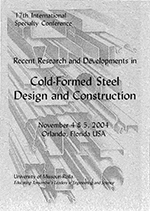Session Dates
26 Oct 2006
Abstract
Cold-formed steel members are widely employed in steel construction because their structural components are lighter and more economical than traditional hot-rolled ones. Nowadays, the easy availability and accessible cost of high-strength low-alloy steels, weathering steels and zinc-coated steels have led to members with high width/thickness ratios, rendering them even more susceptible to local buckling, which is characterized by a plate buckling and which can also lead to another buckling mode called distortional buckling, affecting mainly members with edge stiffeners (lipped channels and Z-sections, hat, rack, etc.). Hence, current versions of technical codes for cold-formed steel design have warned about the importance of this phenomenon and has outlined procedures to evaluate bar strength based on distortional buckling, e.g., the simplified model of the Australian/New Zealand Standard AS/NZS 4600 proposed by Hancock & Lau (1987), which was also adopted by the new Brazilian Standard NBR 14762:2001. In this study, an analysis is made about lipped channels under compression and bending, comparing the results obtained through the Brazilian Standard simplified model against those of the elastic analysis via the finite strip method, evaluating the conformity and the range of validity of the simplified model application.
Department(s)
Civil, Architectural and Environmental Engineering
Research Center/Lab(s)
Wei-Wen Yu Center for Cold-Formed Steel Structures
Meeting Name
17th International Specialty Conference on Cold-Formed Steel Structures
Publisher
University of Missouri--Rolla
Document Version
Final Version
Rights
© 2006 University of Missouri--Rolla, All rights reserved.
Document Type
Article - Conference proceedings
File Type
text
Language
English
Recommended Citation
Malite, Maximiliano; Goncalves, Roberto Martins; Neto, Jorge Munaiar; and Chodraui, Gustavo M. B., "Distortional Buckling of Cold-formed Steel Members" (2006). CCFSS Proceedings of International Specialty Conference on Cold-Formed Steel Structures (1971 - 2018). 1.
https://scholarsmine.mst.edu/isccss/17iccfss/17iccfss-session1/1
Distortional Buckling of Cold-formed Steel Members
Cold-formed steel members are widely employed in steel construction because their structural components are lighter and more economical than traditional hot-rolled ones. Nowadays, the easy availability and accessible cost of high-strength low-alloy steels, weathering steels and zinc-coated steels have led to members with high width/thickness ratios, rendering them even more susceptible to local buckling, which is characterized by a plate buckling and which can also lead to another buckling mode called distortional buckling, affecting mainly members with edge stiffeners (lipped channels and Z-sections, hat, rack, etc.). Hence, current versions of technical codes for cold-formed steel design have warned about the importance of this phenomenon and has outlined procedures to evaluate bar strength based on distortional buckling, e.g., the simplified model of the Australian/New Zealand Standard AS/NZS 4600 proposed by Hancock & Lau (1987), which was also adopted by the new Brazilian Standard NBR 14762:2001. In this study, an analysis is made about lipped channels under compression and bending, comparing the results obtained through the Brazilian Standard simplified model against those of the elastic analysis via the finite strip method, evaluating the conformity and the range of validity of the simplified model application.



